The signs of a tight market are literally everywhere you look. Drive by any industrial park, and signs in front of warehouses and factories advertise hefty signing bonuses and hourly wage rates well above what was seen in pre-pandemic days.
And, it’s not just front-line materials handlers in DCs or manufacturing who are in short supply. Companies with supply chain operations also need managers with expertise in fulfillment operations, procurement, transportation management, and other key supply chain functions to keep goods flowing.
But just how big of an issue is this labor crunch among companies with supply chain operations, and what incentives, best practices or new systems are they putting in place to help mitigate the risks of not being able to find and retain enough talent and labor? A new study conducted by Peerless Research Group dug into these questions to find out how difficult the labor crunch has become, and what industry peers are doing about it.
Among the top findings: an overwhelming majority have open positions; a relatively small percentage of respondents think of themselves as highly prepared on the labor and talent front; and exactly two-thirds are increasing hourly wages in a bid to retain more employees.
Are you responsible for interviewing or hiring personnel for your materials handling, logistics and/or supply chain operations for your organization or for those companies with whom you consult? 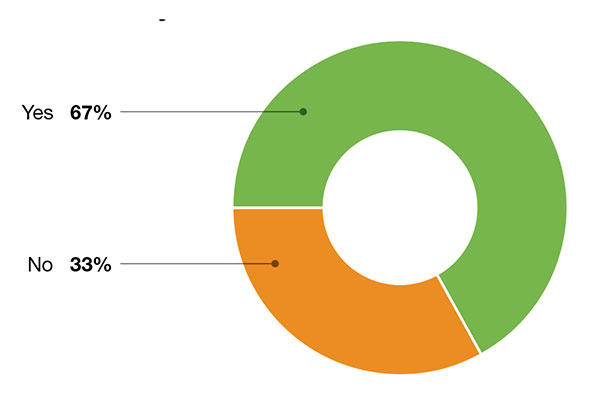 Source: Peerless Research Group
Source: Peerless Research Group
Study background
Modern’s “Talent and Labor Study” was in the field in November 2021, drawing 141 respondents who are registered users of SupplyChain 24/7, a sister media outlet. Nearly seven of 10 respondents (67%) are responsible for interviewing or hiring personnel for materials handling, logistics and/or supply chain operations.
Forty-five percent of these respondents are in manufacturing industries, 15% are with third-party logistics (3PL) companies, and 11% are in transportation and warehousing services. Another 7% are wholesalers, and 7% are with consulting companies. In terms of job function, the top two areas were warehouse operations leadership (director, manager, supervisor) at 45%, followed by 28% in company senior management roles.
The respondent base serves multiple channels, with 37% reporting they serve both businesses and consumers, 57% are focused on business-to-business customers, and 7% have a business-to-consumer focus.
Who are your primary customers?  Source: Peerless Research Group
Source: Peerless Research Group
Perhaps not surprising given the essential nature of warehouse operations in this age of e-commerce, a strong majority are looking to hire. The survey found 81% are looking to fill open positions within the next 12 months, with 19% indicating they aren’t looking to fill open positions.
Various supply chain positions are needed, including front-line DC associates as well as higher-level managers. The top need (61%) was warehouse workers, including warehouse associates, order pickers and maintenance techs. Second was transportation and logistics managers (45%), followed by warehouse managers and supervisors (42%).
How prepared are you in handling your workload with your current staff? 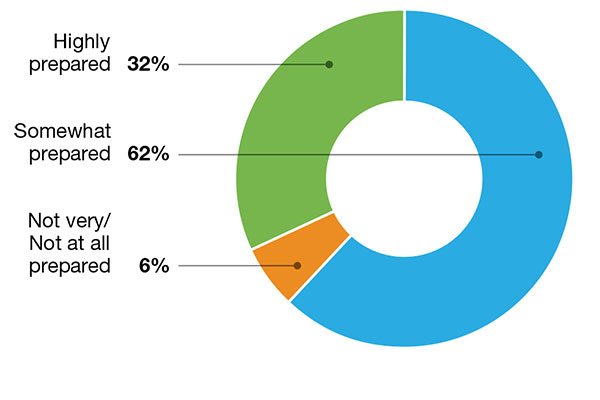 Source: Peerless Research Group
Source: Peerless Research Group
Another 36% named inventory or materials managers as a staffing need, and 29% said e-commerce or order management functions. We left a space under “other” for write-ins, which drew responses including manufacturing positions, procurement roles, sales, supply chain analysts and people with systems integration skills.
Less than one-third (32%) believe their companies are “highly prepared” to handle their workloads with current staff. Most (62%), however, are in the middle, saying that they are “somewhat prepared” to handle demand with current staff, while another 6% admit they are not very or “not at all” prepared.
We also asked respondents to rate their business on employee retention, and additionally, employee recruitment, across a scale from excellent to poor. Generally, respondents felt a bit stronger about their ability to retain labor and a bit less positive about recruitment.
For example, 9% rated their business as “excellent” at retention, while 31% rated their company as “very good” at retaining talent. By contrast, 1% feel they are excellent at recruitment, and 20% rated their company as very good at recruitment.
For the most part, a bell curve is at play here, in that the biggest percentages tended to fall into the “good” or “fair” slots. For instance, 36% said they are only “fair” at recruitment. Another 7% of respondents rated their business as “poor” when it comes to recruitment.
When it comes to actions being taken to improve retention, the leading choice was “increasing hourly wages,” cited by 66%. Another 52% are increasing bonuses, while 39% are offering overtime pay, and 19% are taking other actions.
In write-in comments for other actions, some of the actions included incentive pay, education and health care benefits, and bonuses for taking additional shifts or a good attendance record.
Coping strategies
While implementing new technology is certainly part of the strategy mix to mitigate the risk of not having enough human resources, our survey showed other actions are also taken to help fill gaps.
What actions are you taking to address any current talent shortages?  Source: Peerless Research Group
Source: Peerless Research Group
When we gave respondents a choice of several “actions” currently being taken to address talent shortages, the most frequently cited one was “cross functional training,” cited by 74%, or nearly three-fourths of all those surveyed. In the second spot was improving retention practices (60%), followed by improving skills of the current workforce (58%), increasing headcount (43%) and streamlining processes (37%). Another 30% said they are implementing or starting retention practices.
Implementing new technologies, as an action taken to address the talent/labor shortage, was cited by 23%. When asked to write in which technologies, mentions included automation, supply chain control towers, and applications such as enterprise resource planning (ERP), warehouse management system (WMS), and transportation management system (TMS) solutions.
Are you looking to fill any jobs/open positions within the next 12 months? 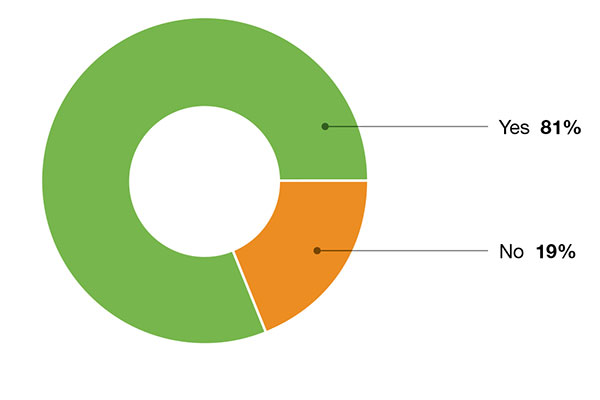 Source: Peerless Research Group
Source: Peerless Research Group
Of course, there can be multiple drivers, such as the need to speed up order fulfillment, or reduce inventory costs, rather than just mitigate a labor or talent gap.
Related Article: Managing people and bots together.
In a separate survey in this issue (page 24) on automation use trends, we found that labor availability concerns shot up as a reason for deploying warehouse automation. According to that survey, inability to find and retain DC associates is now the third leading driver for warehouse automation, up from the sixth spot the year before.
Challenges cited
When we asked what are or recently have been some of the challenges in hiring enough people with the right skills, the top challenge was a tie, with “too few job candidates” and “candidates lack required skills or knowledge” both cited by 60%.
Another 56% agreed there’s too much competition for too few workers, while 37% agreed potential workers are too inexperienced in real-world practices and applications. Twelve percent said “other” as a challenge, with some of the write-ins including people not showing up for interview, people leaving the workforce, or issues with poor work ethic or unrealistically high salary expectations.
We also asked, generally, how well prepared individuals are entering the job market. Six percent said candidates are “highly prepared,” while most (65%) rated the candidate pool as “somewhat prepared,” and 30% said not very or “not at all” prepared.
In which areas are you hiring to better support current challenges in your materials handling, logistics and supply chain operations? 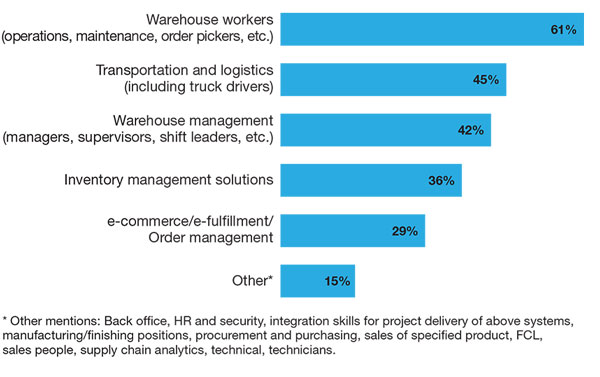 Source: Peerless Research Group
Source: Peerless Research Group
We followed up by asking for ad-hoc comments on why they feel the way they do about the general level of preparedness in the talent pools, and we drew many comments, ranging one respondent saying candidate volume is “way down,” to the “competitive market” for talent cited by another. Other comments focused in on lack of skills, experience, such as one who commented that candidates “lack of experience and not prepared for the physical expectations” of the role. “College grads lack practical experience,” offered another.
Others focused on the need for improvements with education, with one stating that “we have a gap with the semi-skilled workforce because we do not address these positions within public education.” However, another respondent wrote that there are “significantly more education programs geared at supply chain management these days.”
What are/have been some of the challenges you encounter?  Source: Peerless Research Group
Source: Peerless Research Group
One respondent was more sanguine about the overall state of the talent pool today, offering that, “The challenges that we are facing never happened before. We all have to adapt.”
Go-to talent sources
We asked respondents which sources they use for recruiting, giving them options. The top choice was job search websites (71%), followed by word of mouth and networking (65%), social networking websites (62%), search firms (46%), and industry or professional associations (41%). Other sources included job fairs, universities and colleges, and on-campus job fairs. Write-in ideas included advertising and signage, and work-release programs.
How would you rate your business across the following business performance metrics? 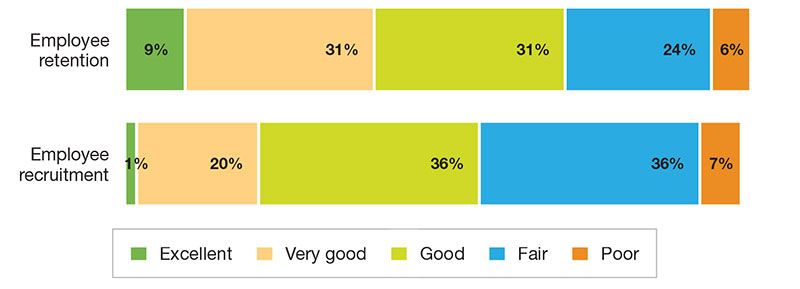 Source: Peerless Research Group
Source: Peerless Research Group
We also asked about the sources or educational institutions job candidates have been hired from. The top choice was a tie between undergraduate programs and hiring from within the workforce—both at 46%. There was another tie for third spot (both at 41%) between community college programs and the military. “Other graduate degrees or programs” were the source of hires for 29% of respondents.
The survey showed that most respondents are hiring, but many see significant hurdles in being able to attract and retain enough qualified talent. While industry concerns about labor availability have been growing for years, the concerns appear to be increasing in severity.
When recruiting, which source(s) do you use? 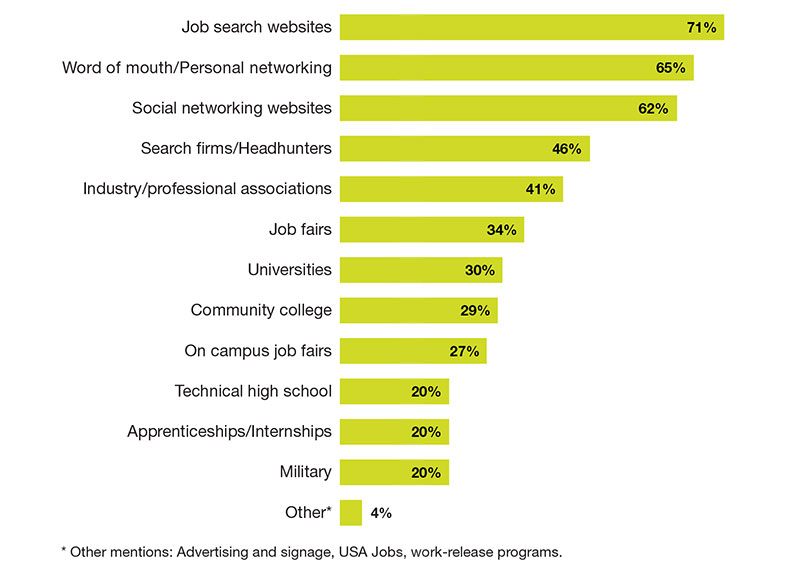 Source: Peerless Research Group
Source: Peerless Research Group
Also, as our survey shows, addressing the talent gaps calls for a multifaceted approach. Our survey found it involves using new technology for some, but also involves best practices like cross-training more employees, improving recruitment and retention, as well as using methods like pay increases, bonuses and incentives.
packers and movers bangalore
packers and movers bangalore near me
packers and movers bangalore cost
packers and movers bangalore to hyderabad
packers and movers bangalore price
packers and movers bangalore marathahalli
packers and movers bangalore to chennai
The post Supply Chain Survey: Talent and labor on the rise first appeared on shrisaimovers.
Packers And Movers Banashankari Bangalore a Packers And Movers Banashankari Bangalore a Packers And Movers Jayanagar Packers And Movers Jayanagar Packers and movers Packers and movers in peenya Packers and movers in peenya Packers and movers near me Packers and movers near me Yelahanka Packers and movers Yelahanka Packers And Movers Btm Layout Packers And Movers Btm Layout Packers And Movers Koramangala Packers And Movers Koramangala Packers And Movers Hsr Layout Packers And Movers Hsr Layout Packers And Movers Bommanahalli Packers And Movers Bommanahalli Packers And Movers Begur Road Packers And Movers Begur Road Local Packers And Movers Bangalore Local Packers And Movers Bangalore Packers And Movers Ramamurthy Nagar Packers And Movers Ramamurthy Nagar Packers and movers Bangalore Packers and movers Bangalore